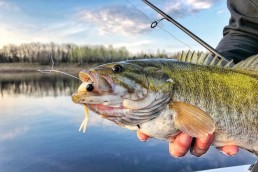Early-Season Smallmouth Bass
SHARE THIS POST
For Jason Mitchell, smallmouth bass provide joy and excitement, whether their digging in below the boat or displaying their airborne acrobatics, they’re simply fun to target and catch.
Smallmouth bass will typically spawn when the water temperatures reach the low 60s, but fish will move shallow long before. Stable and warming water temps often create tremendous shallow-water fishing opportunities. Cold fronts will often momentarily push fish off these shallow locations—but only temporarily.
Smallmouths typically look for rock, boulder and gravel locations in which to bed. Reefs and shorelines that offer this rock/rubble bottom are prime. If I had to pick a perfect location to find shallow smallmouth in the spring, that location would be a large, shallow flat or reef that protrudes from the shoreline where there are scattered rocks that range between the size of a baseball to the size of a bowling ball.
Some of my favorite locations that often get overlooked or missed by other anglers are simply shallow rock spines that are slightly offshore, perhaps a hundred yards.
Polarized glasses are a must for reading water, and side imaging can also help immensely. To really maximize the potential of side imaging, I often like to search through an area with my bowmount trolling motor down and lift my outboard motor so I get a better reading off both sides of the transducer. When I see patches of rock or boulders, I move the crosshairs to mark that location with a waypoint. You can bump fish off a location if you move too close, but the fish typically return, so if you have to get your boat right on top of a location to really learn the spot, do what you have to do to understand what you are fishing.
For simply covering water and fishing through locations relatively fast, jerk baits like the Salmo Rattling Sting are simply deadly. The lures have a long-cast weight-transfer system that allows for launching casts, which is important early in the year when you must be able to reach spots and cover water. Snapping the rod forward will cause the lure to slash and careen in opposite directions, but the pause or stop between the snapping cadence is often what triggers strikes.
Are you enjoying this post?
You can be among the first to get the latest info on where to go, what to use and how to use it!
One change we have seen, however, on some fisheries is the move deeper by bedding bass. This seems to correlate with angling pressure. On heavily fished water, we are seeing more bass bedding in much deeper water. Depending on the lake, these deeper locations are often 7 to 15 feet of water. This is where deeper-diving crankbaits and even some square bills can really shine.
There are times, however, when soft baits shine, particularly with extremely clear water or post-frontal conditions that cool down water temps. My favorite all-time plastic for early season smallmouths in shallow water would have to be a fluke-style plastic. Flukes can be fished slowly unweighted or fished faster like a jerk bait by simply rigging on a darter head. You can also drop shot flukes, particularly if you are fishing over deeper 10- to 15-foot locations offshore.
Spend time to really learn spots and fish from a comfortable distance.
Gain more outdoor knowledge from the pages of MidWest Outdoors, available the first full week of each month at the newsstand or by subscribing on our website.
MWO
SHARE THIS POST
You may also like...
Nothing found.
Did you enjoy this post?
You can be among the first to get the latest info on where to go, what to use and how to use it!
Jason Mitchell
Jason Mitchell was a top walleye guide on Devils Lake, N.D. for nearly 20 years. Today, Mitchell produces the Jason Mitchell Outdoors TV program. Visit jasonmitchelloutdoors.com for more.
